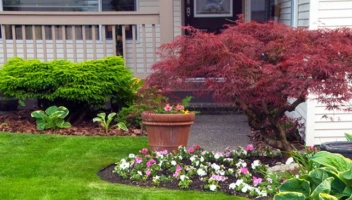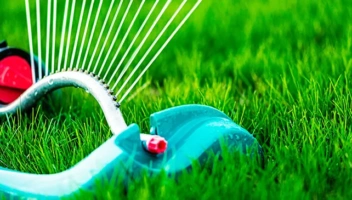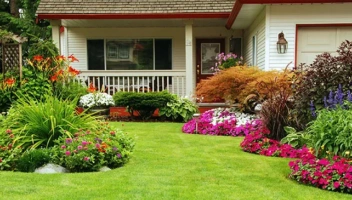Which Soil is Best for Your Area?

If you want to have a successful garden this summer, it’s time to get the dirt on…well…dirt. Soil may seem like a simple topic, but there are actually a lot of factors that many aspiring gardeners are unaware of.
That’s why, in this article, we’ll break down soil by texture and type, and then help you figure out what kind of garden soil you might have in your own backyard based on your region. We’ll also teach you how to get down and dirty to supercharge your gardens with the right nutrients. Don’t worry – it’s easier than it sounds!
Soil Textures
There are four different types of garden soil – clay, sand, silt, and loam. Knowing the texture of the dirt in your garden will help you determine what nutrients you may be lacking, whether you should be worried about drainage, and if you can even grow plants successfully in your gardens.
Here’s a breakdown of the four textures:
Clay
Often described as sticky, or gummy, clay is very dense and moist. You can mold clay-textured soil, and it will retain its shape. It may also be very difficult to dig into it, and, although it is usually very nutrient-rich, plant roots may have a hard time breaking through the clay to reach them. Because it is so dense, clay doesn’t drain well, so you may see puddles after a big rain. These features make clay less than optimal for planting gardens.
Sand
As you can imagine, sandy-textured soil feels gritty and slightly moist, much like the sand you would find on a beach. It does not hold shape well and is low on nutrients. Sandy-textured soil drains very fast, so it doesn’t hold water long enough for plants to get a good drink. Sandy land is very drought-prone. If you have sandy-textured gardens, planting is not recommended without some TLC.
Silt
Silt is fine in texture. When dry, silt is often described as soft, smooth, or powdery. When wet, silt may feel creamy, much like the “typical” feel of mud. Silt tends to hold water, but not as much as clay. Silt is also extremely nutritious. Plants are able to grow in silty soil despite some of the drawbacks.
Loam
Loam, a mixture of clay, sand, and silt, is the optimal type of garden soil. It holds water well, but also drains within a reasonable amount of time. It is very fertile and allows plants to take hold and spread their roots easily.
Soil Types
There are 12 different soil types. Soil types differ by region for many reasons. The former and/or current presence of glaciers, volcanoes, rivers, and other natural landscape features is one determining factor. Other factors include climate, living organisms, organic material, and the amount of time since land formation.
So, what type of soil do you have? There are a few different ways to decipher what type you have. First, we’ll break down the typical soil types by region. Then, we’ll tell you how to test the dirt yourself for the best results.
Soil Types by U.S. Region
Due to the ever-changing nature of the land, two types of soil are commonly seen throughout the United States – entisols and inceptisols. These types of soil are newer than the others and have few defining characteristics. Inceptisols have very little nutrient development and are clay-textured. Entisols have not had a chance to develop nutrients, as they form due to natural events like flooding and landslides.
Otherwise, soil types vary from state to state, but there are some trends in soil types by region. Below, you will find the most common soil types in each U.S. region, but note that, even if you live in one of these areas, the type of garden soil in your own backyard may be vastly different!
Northwest- Andisols
Andisols come from the breakdown of volcanic ash and are usually very fertile. You’ll usually see andisols in areas that get a good amount of rainfall and have cool temperatures. If you have andisols in your yard, good news! It’s perfect for planting!
West- Mixture of Many Soil Types
The Western portion of the United States is made up of many different types of soil. If you live in the western portion of the United States, it will be hard to narrow down which type you have in your backyard without formally testing to measure pH and nutrients.
South West- Aridisols and Vertisols
Not surprisingly, the desert climate of the South West has a big influence on soil type. You’ll usually find dry, nutrient-lacking aridisols and clay-like, nutrient-rich vertisols, which tend to form big cracks when dry.
Midwest- Mollisols and Alfisols
The grasslands of the Midwest offer the perfect climate for the formation of mollisols. This is a very nutrient-rich type of dirt and, because of this, looks very dark in color. The Midwest is also notorious for its many forests, which is why the other most common soil is alfisols. Alfisols tend to be a little less acidic than other types and are relatively fertile as well.
Southeast- Ultisols with More of a Mixture of Different Soil Types in Florida
Most of the Southeastern portion of the United States is comprised of ultisols. The humidity of the southeast is perfect for the formation of ultisols. It is not optimal for planting, as it is acidic, and lacking in nutrients.
Mid-Atlantic- Mixture of Histosols, Ultisols, and Alfisols
The three dominant soil types in the Mid-Atlantic are present due to the moisture the area typically sees. Histosols usually form in boggy areas, which are not optimal for growing. However, this type of soil is rich in nutrients, and with proper drainage, it can be very beneficial for gardening.
Ultisols are not good for planting whatsoever because, as mentioned earlier, they are acidic and low in nutrients. Alfisols are slightly better for planting, as they are less acidic. If you live in the Mid-Atlantic, it’s a good idea to perform a soil test before making any soil amendments.
Northeast- Histosols and Spodosols
The Northeastern coastal region of the United States is notorious for its sandy soil, which is also known as spodosols. This sandy, acidic dirt is not good for planting. In some spots, you’ll also find histosols due to the moist climate during the summer months. While bogs and wetlands won’t be good for gardeners, properly drained histosols will allow plants to thrive.
Alaska- Gelisols and Histosols
Alaska’s climate is not seen in the continental U.S., so it comes as no surprise that their soil is vastly different as well. In some areas, you may see histosols, but Alaska is predominantly made up of gelisols. This type of soil is permanently frozen, meaning it is devoid of nutrients. In other words, it is impossible to successfully grow anything in gelisols.
Hawaii- Andisols and Oxisols
The tropical climate in Hawaii allows for the formation of clay-heavy oxisols. They do not have many nutrients but can be easily amended with fertilizers. Hawaii’s many volcanoes also make prime conditions for nutrient-rich, plant-friendly andisols.
Soil Tests
DIY Testing
For an easy (and cost-free) DIY soil test, simply fill a clear mason jar halfway with dirt from your garden. Fill the rest of the way with water. Then, let it sit and settle out for four to five hours. You’ll begin to see layers of different textures, which you can then use to determine which of the soil types you have.
At-Home Test Kit
Basic garden soil test kits can be purchased at most home improvement stores. They may have a wide range of results, so if you’d like to know very specific pH and nutrient levels, this might not be the test for you. If you’re comfortable with a ballpark estimate just to get started on the right path, at-home test kits are your best option.
Optimizing Garden Soil
No matter what type of soil you have in your gardens, your plants will suck up many of the nutrients naturally present in your gardens. Because of this, you’ll need to make sure to replenish nutrients on a regular schedule (every few years or so).
Composting is great for these purposes. Even if you don’t compost, this can be done by adding organic material, such as eggshells, coffee grinds, banana peels, small amounts of fireplace ash, and dead leaves straight onto the base of your plants, as the beneficial nutrients will automatically be absorbed.
You can also try adding some manure, and regularly fertilizing to supercharge your garden soil. It is also a good idea to mix in some potting soil when you transplant new plants in your garden.
In addition to these strategies, if you’ve determined that your garden soil is mainly comprised of clay, you can break it down using additives like peat moss, vermiculite, gypsum, sand, or greensand.


